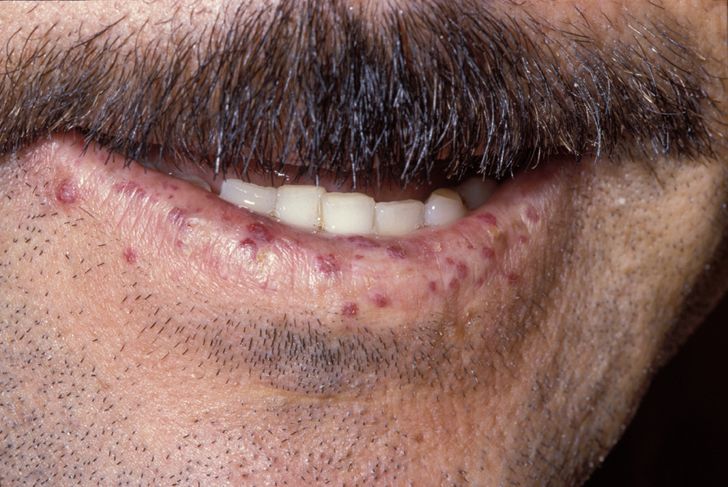Hereditary hemorrhagic telangiectasia
(Redirected from Hereditary haemorrhagic telangiectasia)
Editor-In-Chief: Prab R Tumpati, MD
Obesity, Sleep & Internal medicine
Founder, WikiMD Wellnesspedia &
W8MD medical weight loss NYC and sleep center NYC
| Hereditary hemorrhagic telangiectasia | |
|---|---|

| |
| Synonyms | Osler-Weber-Rendu syndrome |
| Pronounce | |
| Specialty | Medical genetics, Hematology |
| Symptoms | Nosebleeds, telangiectasia, gastrointestinal bleeding, anemia |
| Complications | Pulmonary arteriovenous malformations, cerebral arteriovenous malformations, liver arteriovenous malformations |
| Onset | Childhood to adulthood |
| Duration | Lifelong |
| Types | N/A |
| Causes | Genetic mutation |
| Risks | Family history |
| Diagnosis | Clinical diagnosis, genetic testing |
| Differential diagnosis | Von Willebrand disease, hemophilia, capillary malformation |
| Prevention | None |
| Treatment | Laser therapy, embolization, iron supplementation, blood transfusion |
| Medication | Tranexamic acid, bevacizumab |
| Prognosis | N/A |
| Frequency | 1 in 5,000 to 1 in 10,000 |
| Deaths | Rare |
- HHT is a disorder in which some blood vessels do not develop properly.
- A person with HHT may form blood vessels without the capillaries (tiny blood vessels that pass blood from arteries to veins) that are usually present between arteries and veins.
- The space between an artery and a vein is often fragile and can burst and bleed much more easily than other blood vessels.
- Men, women, and children from all racial and ethnic groups can be affected by HHT and experience the problems associated with this disorder, some of which are serious and potentially life-threatening.
- Fortunately, if HHT is discovered early, effective treatments are available. However, there is no cure for HHT.
Signs and symptoms[edit | edit source]
- Nosebleeds are the most common sign of HHT, resulting from small abnormal blood vessels within the inside layer of the nose.
- Abnormal blood vessels in the skin can appear on the hands, fingertips, face, lips, lining of the mouth, and nose as delicate red or purplish spots that lighten briefly when touched.
- Bleeding within the stomach or intestines is another possible indicator of HHT that occurs because of abnormal blood vessels lining the digestive tract.
- Additional signs of HHT include abnormal artery-vein connections within the brain, lungs, and liver, which often do not display any warning signs before rupturing.

Causes of HHT[edit | edit source]
HHT is a genetic disorder. Each person with HHT has one gene that is altered (mutatedexternal icon), which causes HHT, as well as one normal gene. It takes only one mutant gene to cause HHT. When someone with HHT has children, each child has a 50% chance to receive the mutant gene from his/her parent, and therefore to have HHT, as well. Each child also has a 50% chance to receive the normal gene and not be affected with HHT. At least five different genes can cause HHT, three of which are known.
Diagnosis[edit | edit source]
HHT can be diagnosed by performing genetic testing. Genetic testing can detect a gene mutation in about ¾ of families with signs of HHT, which if found can establish the diagnosis of HHT in individuals and families who are unsure about whether they have HHT. HHT can also be diagnosed by using clinical criteria (presence of signs and a history of signs in a parent, sibling, or child).
Genetic testing[edit | edit source]
Genetic tests are available for the ENG, ACVRL1 and MADH4 mutations.
Complications and Treatments[edit | edit source]
The complications of HHT can vary widely, even among people affected by HHT in the same family. Complications and treatment of HHT depend on the parts of the body that are affected by this disorder. Treatment may include controlling bleeding and anemia and preventing complications from abnormal artery-vein connections in the lungs and brain.
| Cardiovascular disease (vessels) | ||||||||||||||||||
|---|---|---|---|---|---|---|---|---|---|---|---|---|---|---|---|---|---|---|
|
Search WikiMD
Ad.Tired of being Overweight? Try W8MD's physician weight loss program.
Semaglutide (Ozempic / Wegovy and Tirzepatide (Mounjaro / Zepbound) available.
Advertise on WikiMD
|
WikiMD's Wellness Encyclopedia |
| Let Food Be Thy Medicine Medicine Thy Food - Hippocrates |
Translate this page: - East Asian
中文,
日本,
한국어,
South Asian
हिन्दी,
தமிழ்,
తెలుగు,
Urdu,
ಕನ್ನಡ,
Southeast Asian
Indonesian,
Vietnamese,
Thai,
မြန်မာဘာသာ,
বাংলা
European
español,
Deutsch,
français,
Greek,
português do Brasil,
polski,
română,
русский,
Nederlands,
norsk,
svenska,
suomi,
Italian
Middle Eastern & African
عربى,
Turkish,
Persian,
Hebrew,
Afrikaans,
isiZulu,
Kiswahili,
Other
Bulgarian,
Hungarian,
Czech,
Swedish,
മലയാളം,
मराठी,
ਪੰਜਾਬੀ,
ગુજરાતી,
Portuguese,
Ukrainian
Medical Disclaimer: WikiMD is not a substitute for professional medical advice. The information on WikiMD is provided as an information resource only, may be incorrect, outdated or misleading, and is not to be used or relied on for any diagnostic or treatment purposes. Please consult your health care provider before making any healthcare decisions or for guidance about a specific medical condition. WikiMD expressly disclaims responsibility, and shall have no liability, for any damages, loss, injury, or liability whatsoever suffered as a result of your reliance on the information contained in this site. By visiting this site you agree to the foregoing terms and conditions, which may from time to time be changed or supplemented by WikiMD. If you do not agree to the foregoing terms and conditions, you should not enter or use this site. See full disclaimer.
Credits:Most images are courtesy of Wikimedia commons, and templates, categories Wikipedia, licensed under CC BY SA or similar.
- Diseases of arteries, arterioles and capillaries
- Vascular-related cutaneous conditions
- Respiratory diseases
- Neurological disorders
- Autosomal dominant disorders
- Cell surface receptor deficiencies
- Syndromes affecting the nervous system
- Syndromes affecting the lung
- Syndromes affecting the gastrointestinal tract
Contributors: Kondreddy Naveen, Prab R. Tumpati, MD



